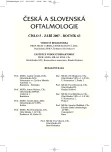Transmissing Electron Microscopy of the Vitreo-Macular Border in Clinically Significant Diabetic Macular Edema
Authors:
S. Synek 1; L. Páč 2; M. Synková 1
Authors‘ workplace:
Klinika nemocí očních a optometrie FN u sv. Anny a LFMU, Brno
přednosta doc. MUDr. S. Synek, CSc.
1; Anatomický ústav, LFMU, Brno
přednosta prof. RNDr. Petr Dubový, CSc.
2
Published in:
Čes. a slov. Oftal., 63, 2007, No. 5, p. 350-354
Overview
The authors examined samples of the epimacular tissue in clinically significant macular edema by means of the transmissing electron microscopy. They did not found morphological differences between samples from patients already treated by means of laser photocoagulation before the pars plana vitrectomy and those without the laser treatment. Findings may be divided into three groups:
(1) the inner limiting membrane (ILM) covered with collagen vitreous fibers, (2) cells’ elements of the fibroblasts category, and (3) fibrous astrocytes in the vitreous cortex constituting one- or multilayer cellular membranes.
Key words:
Transmissing electron microscopy, clinically significant macular edema, diabetic macular edema, peeling of the inner limiting membrane, pars plana vitrectomy
Labels
OphthalmologyArticle was published in
Czech and Slovak Ophthalmology

2007 Issue 5
Most read in this issue
- The Importance of HRT II and Perimeter Octopus 101 in Glaucoma Diseases
- Importance of Structural Examination Methods in the Follow-up of Patients with Ocular Hypertension
- Transcorneal and Transscleral Iontophoresis of the Dexamethasone Phosphate into the Rabbit Eye
- The Treatment of the Exsudative Age-Related Macular Degeneration with Choroidal Neovascular Membrane, its Possibilities and Economical Indexes
